Cultural Touchstones
How some companies get journalistic benefit through becoming touchstones and
how this can lead to their downfall
~ David Straker ~
I used to work at Hewlett Packard, which was
(and still is) of surprisingly wide social benefit. Just dropping the name
into conversation continues to do wonders for my status. Having worked for such
an icon implies both that I am particularly clever to have been admitted to
its hallowed halls, and also that some of its greatness has rubbed off on
me.
Companies such as HP are 'cultural touchstones',
whose names bring value to any conversation. But how do they get that way? As
with more traditional human celebrities, much hangs on the power of the press
and a developed symbiotic relationship.
Media synergy
A typical beginning occurs where a journalist
wants to write a story or a researcher wants to write a paper. They look around
for a successful company, wheedle their way in for an interview and try to find
something different about the company that can be used to explain the success.
This is a win-win arrangement as it not only helps the author but also makes the
company look good to customers and investors.
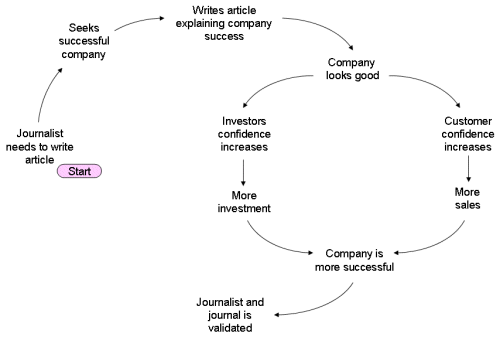
Fig. 1. Journalist-Company synergy
The spiral of success
Synergies also extend outside this relationship
as success stories act as a beacon for other business writers who want either to
write about the same topic or who are looking for more interesting stories and
explanations of success. And so more journalists, researchers and authors flock
to the company's door.
In time, with different articles attributing its success
in different ways, the company develops a reputation of being good all round. A
reversal of journalistic purpose now occurs, as authors who are seeking to prove
a point or pet theory go to the company to see if they do this thing. If they
do, then writer can claim victory: if the company, now widely recognized as
being a fount of good practice, uses what the writer is promoting, then the
point or theory is proven.
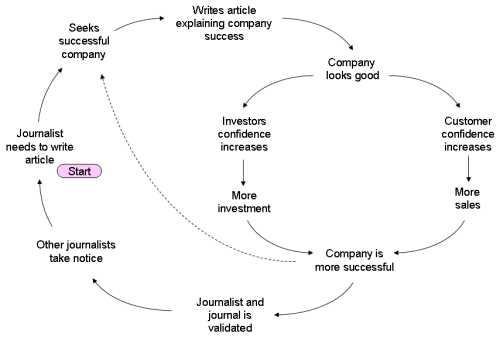
Fig. 2. The virtuous circle of
media-powered success
The company thus becomes a cultural touchstone.
It is not only deemed successful, but anything associated with it gains an
equivalent credibility. The company's name can thus be dropped willy-nilly into
articles for the shine to rub off onto the author's purpose.
The need for touchstones
Business writers need such touchstones to
lend credibility. They also need the company to stay successful and will avoid
writing negative articles in an attempt to journalistically support their
darlings. This does not always work, for example where many of
the companies quoted in Peters and Waterman's seminal 'In Search of Excellence'
(1982)
later failed, causing the authors much embarrassment, not to mention a
significant drop in earnings potential. Peters recovered smartly with 'A Passion
for Excellence' (1985), written with Tracy Austin who had worked at HP and which
referenced more solid examples of success, HP of course included.
This becomes a even more powerful virtuous circle where people
working at the touchstone companies bask in the praise and feel obliged to
deliver on the implied expectation. When friends enviously asked about HP I
parroted the stories of excellence and then worked extra hard to make sure they
came true. The social credibility also extends to recruitment as
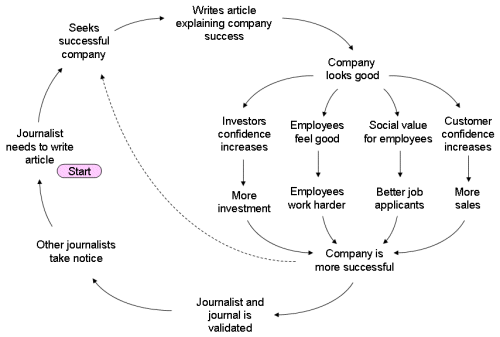
Fig. 3. The full virtuous circle of
media-powered success
Dysfunctional distortion
One of the effects of such narcissistic cycles
is that the gap between what is reported and what is actually happen can widen.
When a journalist asks an executive about the things done at the company, then
of course the executive is going to put a positive spin on it. Distorting
further, the journalist will simplify what they find in order to ensure their
readers get the point. Likewise, academic researchers will focus on their narrow
research topic rather than try to explain the holistic and messy complexity
whereby things often get done.
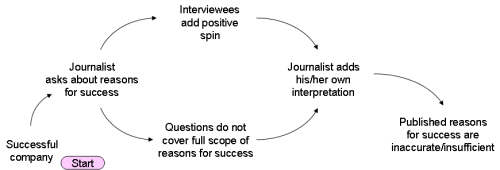
Fig. 4. Distortion in the reporting process
A further distortion and potential failure
occurs when company employees believe the simplified press and subsequently
upset the balance of successful behaviour by focusing more on reported reasons
for success and less on unreported, but essential actions. Now the tail wags the
dog as journalistic fiction becomes a primary driver of business behaviour.
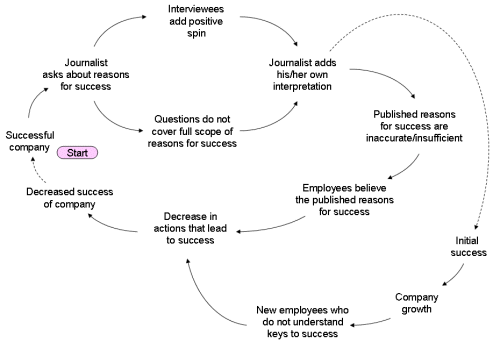
Fig. 5. The media-powered route to failure
Tales of woe
A classic tale of such hazard occurs where a
company provides a pleasant working environment and uses considerate management
practices. The intended result of this is that employees appreciate this and
consequently work harder and longer. The 'nice employer' story is written up,
including in 'best company to work for' lists. This has a benefit to the company
of applicants flocking to their door -- but how many of these really want to
join so they can work all hours? Recruitment procedures are notoriously limited
and, despite best efforts, many will get through the doors whose first goal is a
nice place to work and the social credibility of working at a touchstone
company. Managers also are affected by the 'nice place' press, along with
increasing expectations of their subordinates.
The decline of Digital (DEC) in the 1980s was attributed to this effect,
where terminal niceness led to problems being avoided and consensual decisions
taking forever. HP also suffered to some extent from this effect in the 1990s,
as the buoyant market meant that it could get away with bluntened performance
management as managers sought to keep employees happy and live up to
now-externally-imposed cultural expectations. The fact that Dave Packard could
be a very tough cookie when his high expectations were not met was steadily
being forgotten in the post-founder nostalgia. With the appointment of Carly
Fiorina as CEO, this spiral stopped, though arguably the benefits were also lost
as the cultural baby was thrown out with the bathwater. She increased power
distance and pushed for a more aggressive culture. The momentum of being a
touchstone has carried it through, however, and now, under Mark Hurd it still
has a fascination for journalists and authors. Whether it will remain so, only
time will tell.
The bottom line
Sterman (2000) describes the use of Causal Loop Diagrams as an effective method
of describing how feedback loops lead to amplification, reduction and
oscillation. In these diagrams, arrows point between cause and effect. The '+' sign
between A and B means 'If A increases then B increases, and vice versa'.
The '-' sign means 'If A increases then B decreases, and vice versa'.
From examining these increasing and decreasing forces, it can be seen that some
loops lead to amplification (marked with 'R' for 'reinforcement') whilst others
lead to decrease (marked with 'B' for 'Balancing').
Causal loops tell a story, and this is the simple story in Fig. 6. Effective
methods, by definition lead to success which, as described above leads to the
amplification of media interest, good press and motivation amongst the three key
stakeholder groups of customers, investors and employees. However, this is
offset by misunderstandings that lead to a decrease in the use of those methods
that led to the initial success.
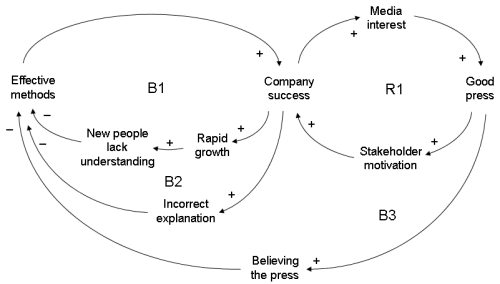
Fig. 6. Media-driven success and failure
The bottom line: don't believe your press. Understand how things really work, including the
complex culture, messy reality and multiple other factors that lead to
sustained success. Be nice to people, but also be tough. Make it a great place
to work, but always motivate towards effective performance.
References
Peters, T.J. and Waterman, R.H. (1982). In Search of Excellence:
Lessons from America's Best-run Companies, NY: Harper-Row
Peters, T.J. and Austin, N. (1985). A Passion for Excellence:
The Leadership Difference, NY: Harper-Row
Sterman, J. (2000). Business Dynamics: Systems Thinking and Modeling for a
Complex World, McGraw-Hill
|